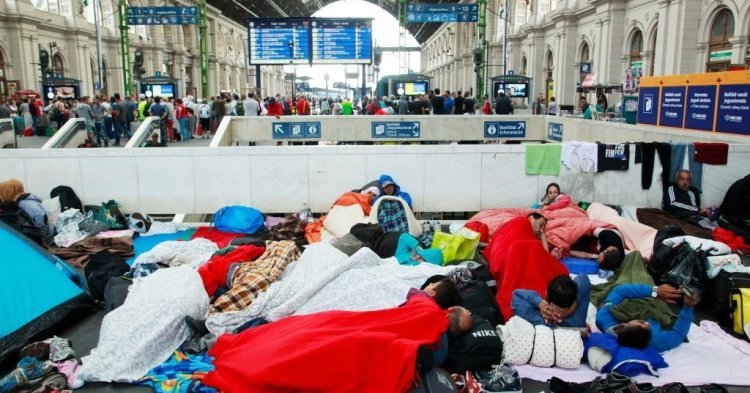One of the main pieces of legislation of the period was the 1990 Dublin Convention. This document represents the foundations of the EU migration policies and the so-called Dublin system which concerns criteria and mechanisms for the examination of asylum applications in the EU territory. But the Dublin system based on the Dublin Convention did not last long. In fact, nine years later in Tampere, the European Union decided to renew its migration policies and align migration norms among its Member States so as to become not only an economic organisation but also a political one.
With this aim of harmonising standards among its Members, the European Union decided for the establishment of a Common European Asylum System (CEAS) to be implemented in two phases, the first one from 1999 to 2004 and the second one from 2004 to 2010.
The first phase of the CEAS: not enough
During the first phase of the CEAS, Member States needed to better define the criteria and mechanisms for determining a State’s responsibility for asylum procedures; the minimum standards on the reception of asylum seekers; criteria to be met by an asylum seeker to become a refugee in the EU; and minimum standards on law-based asylum procedures that could be common to all States which at the time had diverse rules in place.
All of these points became legislation, respectively the Dublin II Regulation, which substituted the Dublin Convention; the Reception Conditions Directive; the Qualification Directive; and the Asylum Procedures Directive. These acts however were only low common denominators and nothing more than the outcome of compromises hard to achieve among States which were opposing any extension of rights for asylum seekers in order to maintain their own flexibility.
Harmonisation, however, had to be reached. A step forward has occurred through the second phase of the CEAS.
The second phase of the CEAS: harmonisation?
To start in 2004 and conclude in 2010, the second phase of the CEAS was supposed to reach complete harmonisation on migration. For it to occur, a decision was made to recast all of the aforementioned legislative measures. The Dublin II Regulation became the Dublin III Regulation and all the directives were amended.
The Dublin III Regulation establishes criteria for allocation of responsibility upon Member States when it comes to examining asylum applications. The main criterion is the “first state of entry rule”, meaning that the country where the irregular immigrant has first entered into the European Union is the country responsible for examination. This system is based on the principle of “mutual trust” which is of utmost importance in the EU. This principle in the field of migration basically means that all Member States have common rules and standards that are based on human rights, democracy and the rule of law. Thus, if a person moves to a second country and is then returned to the country of first entry, certainly their human rights will be respected, as well as democracy and rule of law.
Despite mutual trust and the rule of the country of first entry, it was soon understood that these principles existed in theory but were not fully respected in practice. In 2011 the European Court of Human Rights in the MSS v Belgium and Greece judgment pointed out that Greece does not respect the values of human rights, democracy and rule of law, and hence the country of first entry rule should be disapplied on it. As a consequence, if an asylum seeker enters the EU via Greece and manages to continue to another country, the person will not be sent back to Greece, because the treatment asylum seekers undergo is inhuman and degrading. Not only against Greece, but there have been other similar judgments against Bulgaria, Hungary and Italy with regard to the treatment of minors.
Additionally, the country of first entry rule has also been recognised as burdening countries at the external borders, given that no burden-sharing is provided within the Dublin III Regulation. It has become even more obvious with the large migratory influx of 2015 which made the EU aware of the insufficiency of the CEAS.
Apart from the Dublin III Regulation, the whole set of legislative measures has undeniably moved towards further harmonisation if compared to the first phase of the CEAS. The problem is that this is not enough and States still have wide margin of appreciation when it comes to implementation of EU legislation. That is because the CEAS is mainly composed of Directives which bind Member States with regard to the aims to be achieved, but not with regard to the means to be used to reach those goals.
Novelties at the EU level
For these reasons and especially because of the high number of arrivals in 2015, a third recast procedure of migration legislative instruments was proposed in 2016 by the EU Commission. Among the others, the proposal foresees the shift from Dublin III to Dublin IV Regulation.
The new Dublin IV Regulation would aim at unburdening Member States at the external borders, that is to say those that face the biggest share of responsibility for examination of asylum seekers’ applications. The way to alleviate the pressure on these States is through burden-sharing with responsibility allocated on grounds of States’ GDP, population and unemployment rate.
The problem is that if the countries at external borders would benefit from this measure, the same cannot be said for other EU countries which would perceive this mechanism as an interference with their internal affairs and the way they handle migration on their own sovereign territory. At the same time, the idea behind the new Regulation, as well as the other legal reforms, is to deter irregular migration, as also maintained by the EU Commission.
Has the EU asylum policy failed?
Hence, if one has to assess all that the EU has done so far, four main criticisms can be raised. Firstly, the EU has put under recast procedure the same acts for four times now. Per se, it is undoubtedly a good sign that the EU takes measures where legislation seems not to fulfil its purpose. Yet at the same time, Member States seem to be increasingly reluctant to adopt new measures and continue to re-adopt much the same norms that do nothing but re-affirm the status quo.
Secondly, despite all these reforms, the CEAS has not reached its purpose of harmonisation yet. The directives leave a wide margin of appreciation to States that continue to apply standards that are less and less in conformity with human rights.
Thirdly, the system, as it is now, does not consider the preferences of migrants. Not even in one piece of legislation.
Fourthly, the Dublin III Regulation does not provide for any form of fair burden-sharing, with the result that on one side Member States at the borders have more responsibility and take actions which are in breach of human rights just to “provoke” the EU, and on the other side, the EU does not go further into the application of burden-sharing because some Members States oppose it.
Now, if the system has so many deficiencies, one might wonder what should be done. The current scenario is not that bright, especially given the rise of governments strongly standing against immigration. Undeniably, the proposed reform could re-shape the system and maybe decrease the fear of the “Other” many European citizens share.
Yet, if this reform has to be carried out, I want to highlight it has to be done in full compliance with international human rights law and humanitarian law. Yes, the security of the State is important, yes sovereignty is important, but human beings... they matter.




Follow the comments: |
|
